2 Heads of garlic sliced
6 Shallots sliced
Heaping handful dried chilies
Ground up dried shrimp (chinese, not korean)
2 Cups peanut oil
Fry all ingredients by themselves
Fry 1/2 cup of dried shrimp fried
1/2 cup palm sugar
1.5 tbsp tamarind paste
.5 cup fish sauce
Blend and mix
Author: guseraph
Dan Dan Men
Fine dice holy trinity of ginger garlic scallion.
Saute and add ground pork until brown.
De glaze with black vinegar and rice/sherry vinegar.
Add light soy sauce, sweet soy sauce, Chinese black vinegar, sesame paste, chili garlic oil, and XO sauce.
Add finely ground Szechuan peppercorn.
Add noodles.
Cumin Lamb
This dish could be made and eaten as is, but I’ll add the part where it is incoporated with the BiangBiang Noodles. For this dish, you need a fattier cut of the lamb so avoid using shank, I like using rib meat.
Ingredients
– 300g lamb meat (diced)
– Half cup light soy sauce
– Half cup zhejiang vinegar
– 1/2 tbsp ground cumin
– 1 tbsp fermented garlic/ginger
– 1/2 tbsp potato or corn starch
– 1 tbsp dried red pepper flakes
– 1/2 tbsp ground Szechuan peppercorn
– 1/3 cup peanut oil plus some for cooking
Optional
– 3 cups cabbage and/or bok choy
– Cilantro to garnish
Mix everything but the pepper and oil, cook in a very hot pan with peanut oil. Once the meat is seared, add the greens. Cover to cook through (~10 mins) and take lid off to cook off excess liquid.
Biang Biang Noodles
This recipe is for the noodles only. The recipe for the sauce and the meat are HERE. I separated them because it would have been confusing and too long. Flour to water ratio is 2:1 but it’s not exact, it depends on ambient humidity.
Ingredients
– 250g flour
– 125g water
– Pinch of salt (optional)
– Oil
Mix flour, water, and salt in a bowl and knead by hand until everything is incorporated, should be around 5 minutes. The texture should resemble that of fresh playdough. Roll into a tight ball and place in a clean bowl with about a tablespoon of oil. Roll the dough in the oil to coat it and cover the bowl with plastic wrap. Let it rest refrigerated overnight or at least 1 hour at room temperature.
Cut the dough into 8 even pieces and roll into logs. Things move at a fast pace after this so have water boiling when ready to pull the noodles. The bigger your pot with water, the better.
Place a log on a clean board or countertop and press into a long rectangular shape with your fingers.
Optionally, roll with a rolling pin to make it evenly thick throughout. With a chopstick, make an indentation lengthwise where it will be ripped.
Hold the ends and in a up and down motion, start smacking the dough on the counter while you stretch the noodles out.
Then, rip from the middle where your indentation was to make two strands of noodles. Immediately place in boiling water. It should cook fairly quickly so keep an eye on it, no more than 5 minutes.
Spaghetti Carbonara
If there was one thing I had to eat everyday for the rest of my life, it would be eggs. This dish makes perfect use of them. The only ingredients that need to be somewhat measured are the pasta (to know how many people you can feed) and the eggs (also to match the amount of pasta). The general rule is that a person eats 100g of pasta per plate so just scale it up from there. I’m writing this recipe for two so 200g of dried pasta is what I’m putting down. As for the eggs, it’s one per person and the italians say, “one for the pot”, to account for the little bit left on the sides on the pot. I like to use that “extra” egg as just the yolk for extra richness without the extra liquid. Everything else is up to you but I don’t think there’s such a thing as “too much” cheese or bacon so whenever you think is enough, add a bit more.
A note about the ingredients. Guanciale is bacon made with the jowl of the pig, yes the face. If you can’t find it, you can use pancetta. The curing method for both is pretty similar so it’ll give you a close-enough flavor. Use fresh eggs because yes, we are not really cooking them. If that makes you uneasy, I feel like you might be in the wrong blog. Peccorino is NOT the same as parmesan cheese, it’s sharper, saltier, and generally just more of a jerk. So make sure you use the right cheese. As for the pasta, you can make fresh pasta or get fancy pasta but I think dry pasta is pretty damn good, as long as the brand sounds mildly Italian.
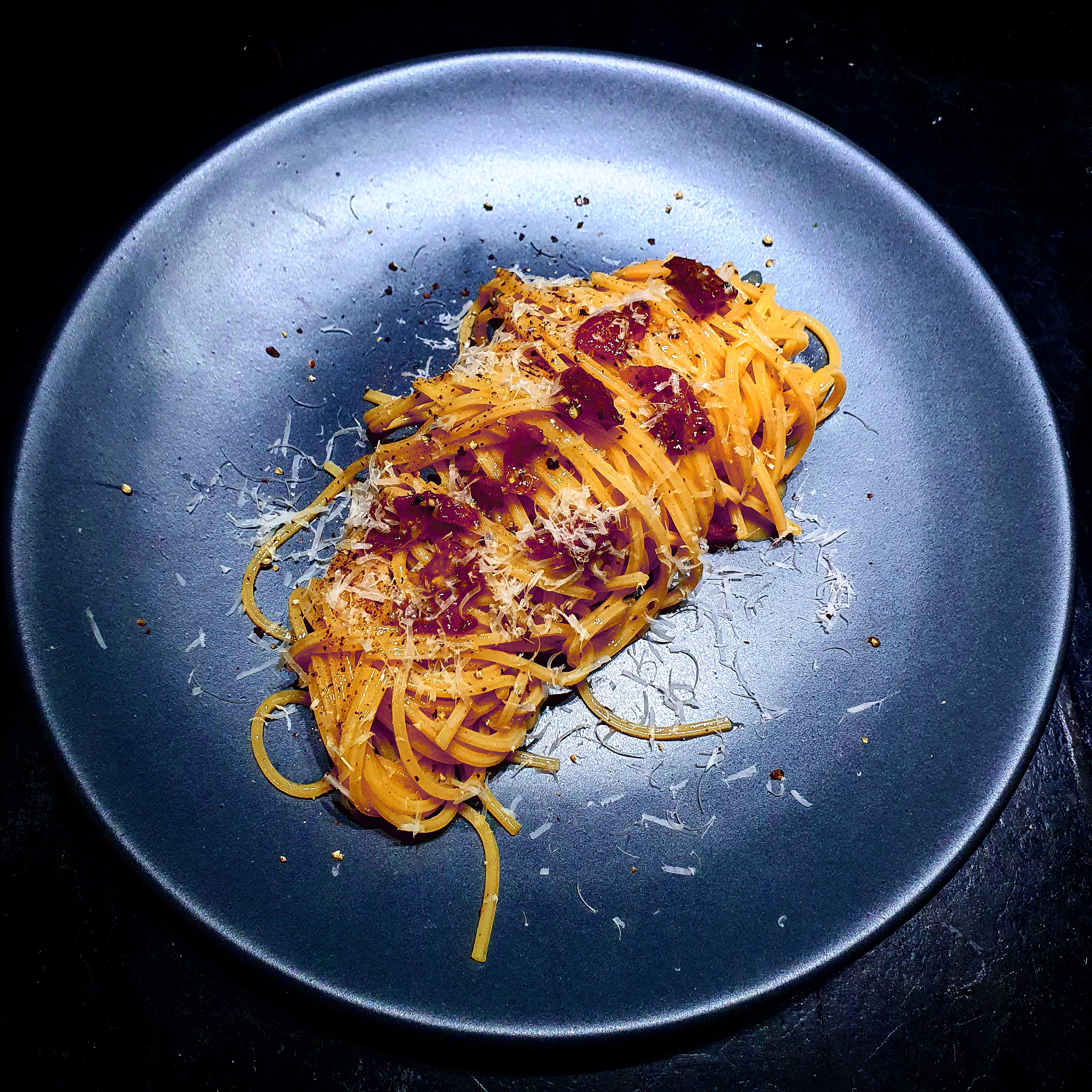
Ingredients
– 200g spaghetti
– Guanciale
– 2 eggs and one extra yolk
– Peccorino Romano (grated finely)
– Black pepper
– Salt
Boil a pot of water and salt it enough so it tastes like ocean water. Once boiling, add pasta and cook per the directions on the box. This is the one time you want the pasta actually cooked all the way or at least slightly past al dente. Do all the next steps while you wait for the water to boil.
Slice the guanciale thinly and spread in a cold pan. Put it on a medium flame until it renders most of the fat out of the pork. It’s done when golden but not extra crunchy. Save the fat.
Whisk the eggs in a large bowl. Once homogeneous, add the peccorino cheese and the pepper. When the guanciale is done cooking, add that to the mixture and finish incorporating it. Let the rendered fat sit in the pan with no heat.
If you’ve timed it right, it should all come together like a well synchronized ballet at the end. Drain the pasta, add it to the warm pan that had the fat in it. Add the egg mixture on top and toss the pasta until it’s all coated evenly.
You should not need to salt it since the guanciale and the peccorino are salty enough, but if you so desire, do so with a finishing salt.
Shakshouka
This is one of the best breakfast foods ever. The only reason I say it’s a breakfast food is not because it’s an egg dish, but because I make the sauce and let it rest overnight. Shakshouka is so vast and is made by so many cultures that you can differentiate where the person learned it by tracing the spices and flavors it has. I learned it from an Egyptian chef in Queens but adapted it to spices my palate is adapted to from Mexico.
Ingredients
– 9 roma tomatoes
– 1 onion
– 4 garlic cloves
– 1/2 cup olive oil
– 1-3tsp smoked paprika
– 1-3tsp oregano
– 1-3tsp toasted cumin
– 1-3tsp turmeric
– 1-2 heaping tablespoons Harissa
– 4 eggs
– Feta cheese
– Handful of spinach
– Za’atar
– Salt & pepper to taste
Score the skins of the tomatoes in a cross pattern and blanch them in boiling water for 30 seconds so you can peel them easily.
In a dutch oven or deep skillet add oil and chopped onions on medium heat. Sweat the onions for 5 minutes and add crushed garlic. Saute for a couple minutes and add the peeled and rough chopped tomatoes, no need to seed them. Add all the spices without the Za’atar and let it simmer until tomatoes are broken down. Crush the tomatoes further with a masher or blend roughly with an immersion blender. There should still be pieces of tomatoes left, it’s not a sauce. Add the harissa to taste, I add two heaping tablespoons because I like it spicy. Pepper it to taste but salt it shy of how you want it.
Simmer for 30 minutes on medium-low heat where it’s bubbling but not splattering. Let cool on counter and place in fridge overnight.
The next morning, add the spinach and bring back to boil uncovered then simmer for 20 minutes. Crack the eggs carefully and cover the whites with the sauce. Cover with the lid and let simmer for 5 minutes. Turn heat off and let sit for a minute more. Uncover and serve with crumbled feta cheese and Za’atar. The feta and the reducing of the liquid should bring the saltiness up enough. The egg yolks should be runny and the whites should be barely set. Enjoy with some crusty baguette.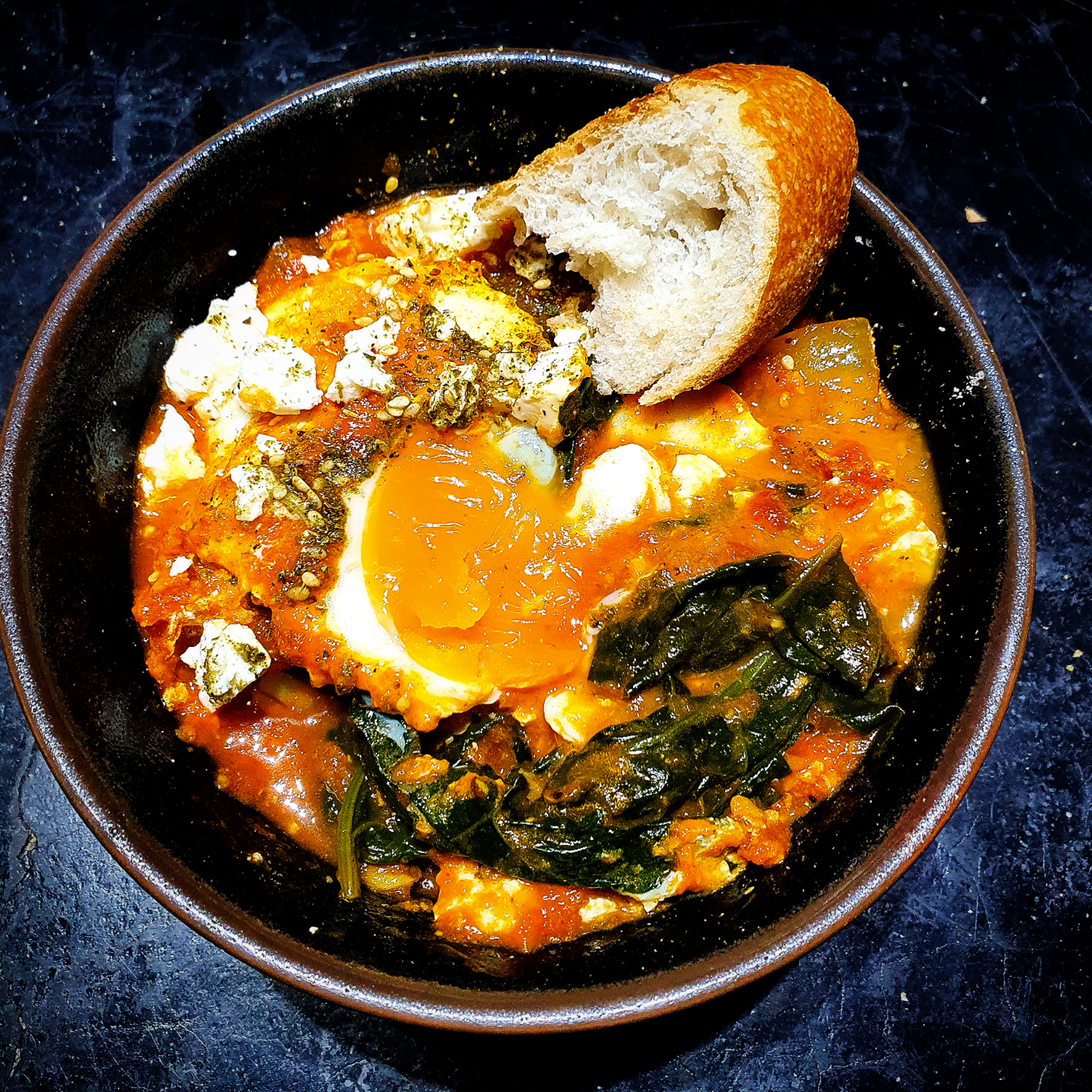
Harissa
The base of Tunisian cuisine, harissa is a spicy, savory, sour, umami-rich flavor bomb. It’s made mainly out of different peppers so I figured it should be made with the best, Mexican peppers.
Ingredients
– 1 red bell pepper
– 1 dried ancho pepper
– 5 dried guajillo pepper
– 15 dried arbol pepper
– 4 cloves of garlic
– Half a white onion
– 1 tablespoon tomato paste
– 2 tablespoons lemon juice
– 1 tablespoon apple cider vinegar
– 2 teaspoons cumin seeds
– 2 teaspoons coriander seed
– 1 tablespoon smoked paprika
– 1 teaspoon black pepper
– Half cup to 1 cup olive oil
– Salt to taste
Blister the red pepper on direct flame until the skin turns black, place it a plastic bag for it to “steam”. This is done so the skin can be peeled easily. While you wait 15ish minutes for that, boil some water and pour over the dried peppers in a bowl to get hydrated. This should also take 15-20 minutes.
In a dry skillet, toast the cumin, coriander, and black pepper until fragrant. Once toasted, grind with a mortar and pestle. 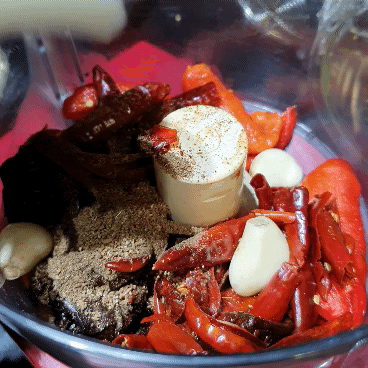
Peel off the skin from the bell pepper and take seeds out of all the peppers. Add everything but the olive oil in a food processor and blend. Once incorporated, drizzle half a cup of olive oil while blending. The consistency should be smooth, not pasty. Add olive oil accordingly. 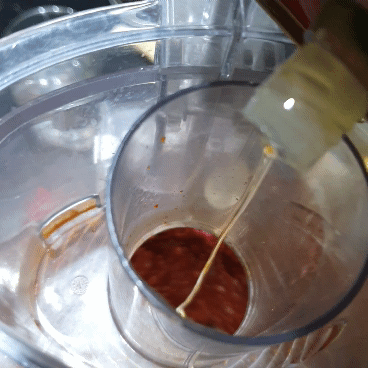
After doing this a few times, I have realized it’s easiest to seed the dried peppers before hydrating and to salt at the end. 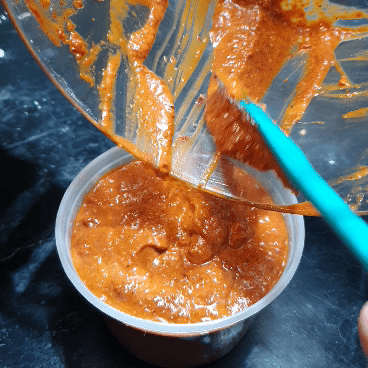
Kimchi
Not all cuisines have staple accoutrements but those that do have them because they found something so great that it had to be eaten with every single meal. Mexicans have salsa, Peruvians have aji, and Koreans have kimchi. It’s the topic of heated debates, mostly because of its overpowering taste and smell. It’s garlicky, funky, stinky, spicy, and delicious. It can be made with pretty much any vegetable but for the sake of simplicity we’ll only talk about the OG cabbage version here. There’s rumors that it is banned from the dorms at the Culinary Institute of America, also that it is what saved Koreans from the avian flu when the outbreak happened all across Asia. Apparently, the lactic acid bacteria and fermentation metabolites in kimchi inhibit the growth of influenza virus, so say a bunch of sources (PRN, BBC, WSJ). Bottom line, it’s stinky but super good for you.
Ingredients
– 1 Head napa cabbage (~2.5kg / ~5lbs)
– 2 cups coarse sea salt
– 4 scallions
– 1 sheet dashima (about the size of your hand)
– 1 tbsp glutinous rice powder
– 2/3 cup gochugaru (Korean red chili pepper flakes)
– 1/4 cup saeujeot (salted fermented baby shrimp)
– 2 fresh oysters (optional)
– 3 tbsp fish sauce
– 5 tbsp fermented ginger and garlic
– Small handful scallions, green onion and/or chives
Cut the cabbage lengthwise into 4 pieces. In a large bowl dissolve a cup of salt in water and bathe the cabbage, making sure you get water in all the nooks and crannies. Take turns with each quarter if the bowl isn’t big enough. Shake off the excess water and generously sprinkle salt between each leaf, concentrating on getting the salt in the thick white parts of the cabbage. This will soften the cabbage to make it malleable. Once salted, submerge in the salt water for 5 to 8 hours. Rotate the pieces if needed so they all spend time underwater. Once the cabbage leaves are easily bendable, rinse it thoroughly.
Boil the sheet of dashima in a cup of water, let cool and add the rice powder. Bring back up to a simmer to make a thin paste. Mix in the ginger+garlic paste, the gochugaru, saeujeot, fish sauce, and diagonal-cut scallions in the paste. Let sit for a few minutes to get the pepper flakes re hydrated. It should have a thick but easily spreadable consistency. Add water if necessary. If adding the fresh oysters, do this process in a blender and add the scallions after it’s blended.
Cut enough off the bottom part of the cabbage for the leaves to still be held on together. Spread the paste evenly between all the leaves. When done, fold the quarters nicely wrapping them with the outermost leaf and place in the container you’ll use to ferment it in. You can definitely just eat it as is but if you want truly magical kimchi, let it sit in room temperature for two to 3 days. Weather, temperature, and how ripe you like your kimchi will determine how long you leave it out. Just taste it as you go.
Bulgogi
Korean recipes are almost never measured. At least the people I have watched, like my mom and aunts, never measure and just go by eyeballing measurements and taste. I guess it’s an old school thing because I’ve seen similar behavior from other ajummas, Mexican doñas, Italian nonnas, and the like. My mother scoffs at measuring cups and instead, gives me measurements from one of our tablespoons and different levels of hand-cuppings. Measurements are given like half a handful, a full handful but with the hand slightly splayed, just the fingers but from the second knuckle up. I have done my best to turn these measurements into standardized cups and spoons but since most of these recipes are scalable, just eyeball them.
Bulgogi might be THE taste of Korean cuisine. It’s the marinade that everyone has tried and associates with Korean food. As soon as you smell the garlicky, soy sauce-y, sesame seed-y fumes, you know someone’s cooking a variation of bulgogi. The name bulgogi translates to fire meat. Technically, it can be any animal and any cut of it, but it’s usually beef. Any variation on animal is usually noted in the name, like dweji bulgogi which is pork bulgogi or dak bulgogi which is chicken.
In this recipe, I’ll concentrate on the marinade. Use any beef you’d like that your budget will allow. Most people use top sirloin or tenderloin when going the inexpensive route, and short rib or ribeye when splurging.
Ingredients
– 1/2 cup soy sauce
– 1/4 cup garlic honey (or regular honey or a bit less brown sugar)
– 4 tbsp mirin (rice wine)
– 1 onion
– 4 tbsp fermented ginger garlic (or 2 tbsp ginger + 2 tbsp garlic, chopped)
– 1 large asian pear
– 5 tbsp sesame seed oil
– Pepper to taste
Slice your meat thin. It helps to either buy it sliced or freeze it for a couple hours before cutting. Blend all the ingredients and marinade the meat for about 5 hours. This is one of those recipes that is hard to mess up. Add more or less honey depending on how sweet you like it. You can’t go wrong with a lot of garlic, so play around with that, too. If you choose to go with less garlic than I recommended, gtfo and don’t come back. Just kidding, but no, really.
Cook on a skillet or grill on medium heat, you don’t want the sugars to burn before the meat is cooked. If you crowd the pan, you end up steaming instead of grilling the meat. It’s not the worst thing to happen since you get a bunch of “sauce” you can mix into your rice, but you won’t get the delicious char. You know what you like, so play around with it. The recipe makes a lot of marinade so you get a few tries to find out how you like it.
Ricotta on Bread
Sometimes I’ll post recipe ideas as they pop up in my mind, without the detailed recipes, like how to make the bread from scratch. Most of the time it’ll be because I feel like other recipes are better than mine. For example, sourdough bread. I, like a bunch of other people in quarantine, tried to keep a sourdough starter going for a few weeks until it turned watery and started smelling weird. That’s when I said fuck it and threw it out. I’ll buy my sourdough from the pros, thank you very much. This recipe is simple enough, buy the stuff and put it together. Ricotta is best when made at home, so I linked the recipe.
Ingredients
– Sourdough
– Ricotta cheese
– Fresh or dry oregano
– Honey
– Finishing salt
Cut the sourdough into half-inch slices and fry it in neutral flavored oil. It’s so much healthier than toasting it. Just kidding, it’s probably terrible for you but it’s oh-so-delicious. Remove from pan and drain on a wire rack or paper towel to drip off that excess oil. Add a healthy scoop of ricotta on the bread, drizzle with honey, sprinkle some oregano and salt. Perfect pre-dinner amuse-bouche.
